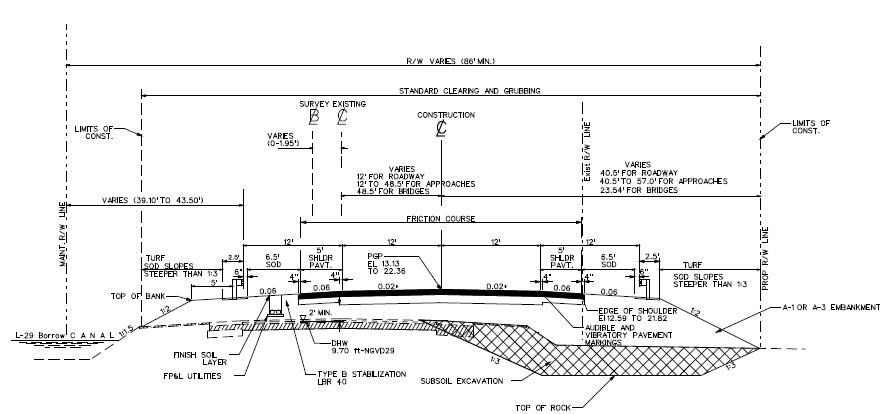Last updated: August 11, 2020
Article
Tamiami Trail: Next Steps

Background. Tamiami Trail is a 264-mile roadway (U.S. Highway 41/State Road 90) that was completed in 1928, to connect the growing cities of Tampa and Miami. Within the Everglades, the roadway embankment was constructed by excavating the underlying limestone, forming what is now the L-29 borrow canal. The excavated material was placed directly on top of the existing Everglades muck soil. Over time the muck has consolidated, which contributes to roadway instability problems.
The east/west Everglades portion of this roadway created a 25-mile impediment to natural surface water flows, and limited inflows to Shark River Slough, within Everglades National Park (ENP). In the mid 1940's a series of 45-foot long timber bridges were added to improve conveyance, but were replaced in the 1950's with smaller culverts. In the early 1960's the western 10-mile section crossing Western Shark River Slough was relocated onto the elevated L-29 levee, and larger water conveyance structures were added as part of construction on the upstream Water Conservation Areas (WCAs). The eastern 10.7-miles of Tamiami Trail between the L-31N and L-67 Extension levees remained lower, limiting our ability to raise water levels and increase flows into Northeastern Shark River Slough (see figure 1).
Eliminating Barriers to Water Flow. The Tamiami Trail (U.S. Highway 41) has long been recognized as one of the primary barriers to flow of water through the ecosystem.The need to eliminate barriers to overland flow of water in the Everglades is considered one of the indisputable tenets of restoration. Much scientific information amassed in recent decades reinforces the importance of removing these barriers to water flow in order to restore natural marsh connectivity.
In 2009, Congress authorized implementation of the plan selected in the 2008 Modified Water Deliveries to Everglades National Park, Tamiami Trail Modifications, Limited Reevaluation Report (LRR). The 2008 LRR plan consists of a one-mile bridge and road improvements to allow the increase in water levels in the adjacent canal to be raised from the current 7.5 feet to 8.5 feet. The LRR plan would improve potential marsh connectivity, reduce sharp changes in water velocity, and improve rainy season depths and durations.In addition, these modifications will improve the ridge and slough landscape and fish productivity, which could result in increased foraging success for wading birds.

The specific restoration objectives from the 2009 Omnibus Appropriations Act included:
- increase potential ecological connectivity between the marshes in Northeast Shark River Slough and the marshes north of the Trail;
- restore natural marsh flow patterns (flow rates and distributions) more associated with unobstructed flows between marshes; and
- restore ridge and slough habitat in ENP by reconnecting historic sloughs that were severed by the existing roadway.
In November 2010, the National Park Service completed the Tamiami Trail Modifications: Next Steps Final Environmental Impact Statement, and the Record of Decision was signed in early 2011. This report presented an environmental analysis of six alternatives: a no-action alternative, and five variations of additional bridging that could be constructed along the eastern roadway, while accommodating access to all of the adjacent developed areas (these include: two Miccosukee Indian camps, three commercial and one private airboat operations, and three radio/telemetry tower arrays). The environmentally preferred alternative (Alternative 6e) recommended the construction of up to 5.5-miles of additional bridging (in four potential locations), and complete reconstruction of the remaining roadway. The recommended roadway reconstruction would remove all of the unsuitable subbase, and raise the top of the finished roadway elevation to approximately 13 feet (NGVD), to accommodate the future CERP projected design high water of 9.7 feet in the L-29 canal (see Figures 2a & 2b).


The Tamiami Trail Modifications Next Step Phase 1 design was developed in coordination with the water flow components envisioned within the CEPP, since increasing flows through the Everglades is dependent on the roadway and conveyance improvements along eastern Tamiami Trail. The CEPP recommended plan included a new Blue Shanty flow-way that would route surface water from the southeast corner of WCA-3A, through a portion of WCA-3B, and then into the L-29 canal and NESRS wetlands, via a degraded section of the L-29 levee. Based on this CEPP configuration, our Next Steps Phase 1 design focused on raising and bridging a 3.2-mile segment of Tamiami Trail at the location of the western most bridge proposed in the 2010 Final EIS (see Figure 3).


Future bridge options evaluated in the FEIS include and .38 mile, .66 mile and 1.77 mile bridge located with the remaining 6.7 miles to be reconstructed.
Future Water Conveyance Options for Phase 2. The restoration objectives from the 2009 Omnibus Appropriations Act focused on increasing ecological connectivity between the NESRS marshes and the WCAs, restoring more natural marsh flow rates and distributions, and restoring ridge and slough habitat within ENP, by reconnecting historic sloughs that were severed by the existing roadway. To address the complex nature of the flow patterns in NESRS, we relied on the prior Army Corps of Engineers RMA-2 modeling of eleven bridging alternatives included in the 2005 Modified Water Deliveries to ENP, Tamiami Trail Modifications; Revised General Reevaluation Report (RGRR). This model utilizes local land features, hydraulic roughness, and topographic data to predict multi-directional flow patterns, flow velocities, and marsh water depths.


NPS Photo


